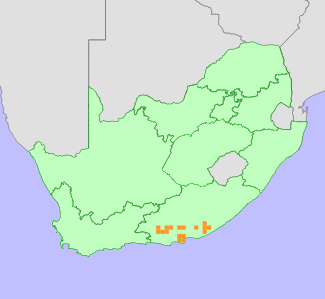|
Scientific Name | Raphionacme zeyheri Harv. |
Higher Classification | Dicotyledons |
Family | APOCYNACEAE |
National Status |
Status and Criteria | Near Threatened B1b(iii,v)+2b(iii,v) |
Assessment Date | 2022/10/27 |
Assessor(s) | N.N. Mhlongo |
Justification | This species has a limited distribution range and has an extent of occurrence (EOO) is 16 229 km and an area of occupancy (AOO) of 76 km². The population is currently declining due to illegal collection for the horticultural trade. It is also threatened by habitat loss as a result of crop farming and housing developments. With the population declining but with more than 10 locations extant it almost reaches the thresholds for listing as Vulnerable under criterion B and is assessed as Near Threatened. |
Distribution |
Endemism | South African endemic |
Provincial distribution | Eastern Cape |
Range | This caudiciform is a South African endemic occurring in the Eastern Cape province. It is known from Mont Pellier, Steytlerville, Jansenville, Fish River Valley and Grahamstown. |
Habitat and Ecology |
Major system | Terrestrial |
Major habitats | Bhisho Thornveld, Southern Karoo Riviere, Willowmore Gwarrieveld, Sundays Valley Thicket, Sundays Arid Thicket, Saltaire Karroid Thicket, Fish Arid Thicket, Doubledrift Karroid Thicket |
Description | Plants of this species grow at an altitude between 100 - 610 m.a.s.l. and can be found in grassland, succulent scrublands and in stony environments. It is commonly found in the Albany thicket and savanna biomes. |
Threats |
| This species has been targeted by illegal collection in recent years and many of the plants observed in South African nurseries and the internet have distinctively wild characteristics. This species has also lost much of its suitable habitat in the past due to crop farming and developments for human settlements. |
Population |
The population is declining due to illegal collection for the horticultural trade. Habitat loss as a result of crop farming and the development of human settlements may have historically impacted subpopulations of this species.
|
Population trend | Decreasing |
Assessment History |
Taxon assessed |
Status and Criteria |
Citation/Red List version | | Raphionacme zeyheri Harv. | Least Concern | Raimondo et al. (2009) | |
Bibliography |
Bredenkamp, C.L. 2019. A flora of the Eastern Cape Province. Strelitzia 41. South African National Biodiversity Institute, Pretoria.
Raimondo, D., von Staden, L., Foden, W., Victor, J.E., Helme, N.A., Turner, R.C., Kamundi, D.A. and Manyama, P.A. 2009. Red List of South African Plants. Strelitzia 25. South African National Biodiversity Institute, Pretoria.
|
Citation |
| Mhlongo, N.N. 2022. Raphionacme zeyheri Harv. National Assessment: Red List of South African Plants version 2024.1. Accessed on 2025/10/14 |
 Comment on this assessment
Comment on this assessment


